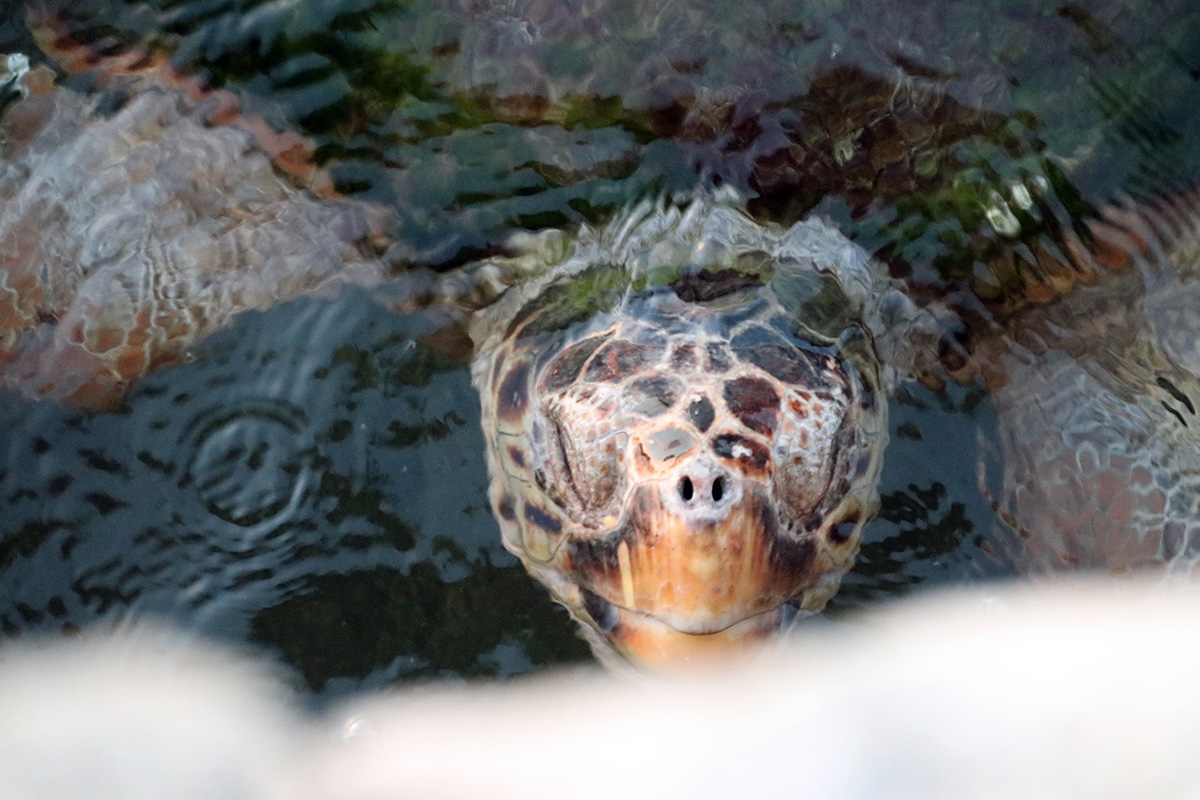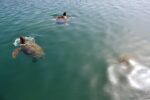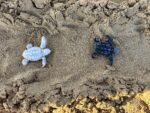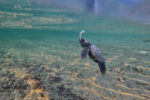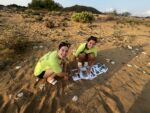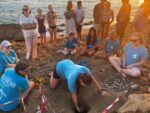Our Latest News – September 26, 2022
Argostoli Field Station
The team in Argostoli have had another eventful week sleeping under the stars on their hatchling rescue shifts. On Wednesday night, the team observed emergences from seven different nests. It was the first night of hatching for five of these, and three experienced mass hatching events. Outstandingly, we saw 102 out of 108 eggs hatch from MA19R, and as a result, the team helped a staggering total of 239 hatchlings to sea in just one night! When taking into account the total hatchling counts from this week, our wonderful volunteers have helped over 380 hatchlings to sea on hatchling rescue, amazing work guys!
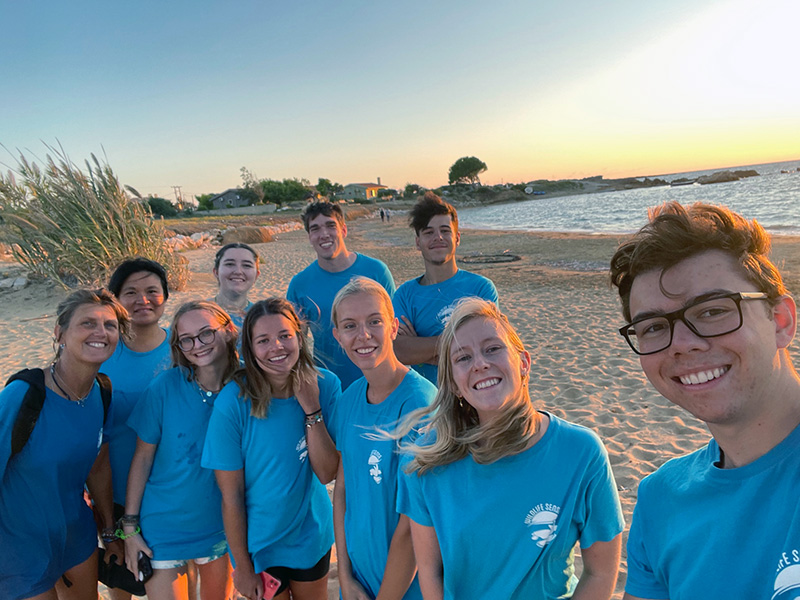
Keeping up with the pace of hatchings, nest inventories have continued to occur throughout the week. Over 80 hatchlings were rescued from underneath their siblings’ hatched eggshells and helped to sea. A rare observation was made during an inventory on Ammes this week. When opening up the remaining unhatched eggs in the nest, a twin embryo was found within one average-sized egg! Our team found it very interesting to discover this extraordinary occurrence.
Our nest counts have dwindled to a total of 14, with 1 remaining on Ammes, and 13 on Megali Ammos. We are very excited for these remaining nests to start hatching in the following few weeks, and to then determine their success by inventory.
This week on the harbour, Daedalus, Tilly and March have been observed, along with our frequently spotted residents – Barb, Syna, Artemis, and Bulbious. On top of this, we are thrilled to report that Shalom was spotted for the first time this season swimming in the harbour, it was a lovely surprise to see the return of a familiar face.
Unfortunately on Wednesday, we received a call concerning a turtle in the harbour who had been spotted dragging a large fishing net. The team rushed down and rescued the turtle from the water to find that it was an untagged male who, we have regularly been spotting in the harbour. After a brief assessment, we confirmed that he had ingested the fishing net and it had begun to come out of the cloaca. This net was removed after a visit to the vet, Spiridoula Vavasi, who also confirmed that he was healthy, allowing us to tag and release him back into the harbour. We look forward to seeing the newly named Marlo again in the harbour free of the net!
In other news, our volunteers have been spending their evenings getting involved in fun group activities. We have enjoyed taking part in games of volleyball, cards, and “Assassin” and also braved a late September sunset swim! With a talented artist amongst the group, the henna night bar was raised and many of our volunteers have spent the week displaying some pretty impressive, and beautiful henna designs. As the current group prepare to say goodbye, we are looking forward to welcoming a new group of volunteers, and seeing what the next week has in store for us.
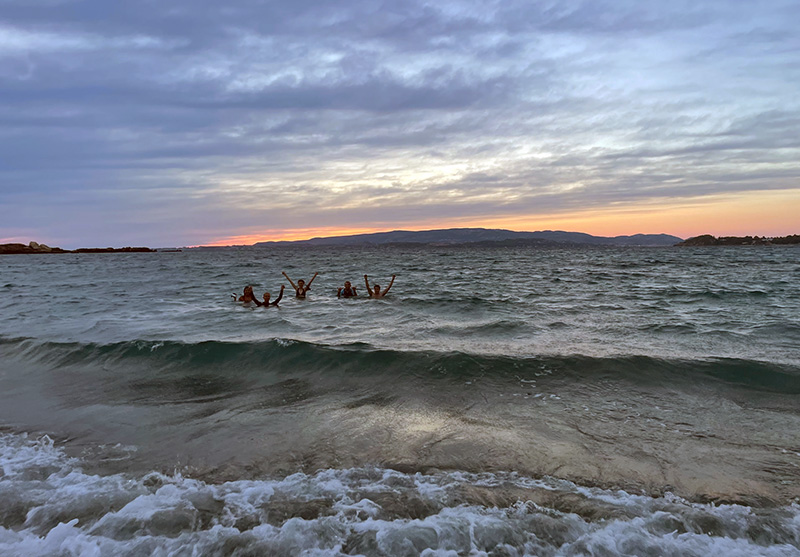
Written by Annabel Bradley and Claire Roche
Lixouri Field Station
There’s a cooler breeze in the air this week in Lixouri, reminding us that the season is coming to a close. However, we still have 9 nests left over on 2 of our beaches, with some of them still to hatch for the first time. However, the work continues with our lovely volunteers collecting heaps of important data, not only about turtles and their nests, but also about the changes in our beaches and the plastic pollution locally, and of course spotting adult turtles in the harbour! Morning surveys are still going strong, with a heavy focus on looking out for nests that are ‘found by hatching’, so our volunteers are going out at sunrise with their eyes peeled looking for the small tracks in the sand.
Our first inventories this week were VR4R and VR5R, which had been hatching quite slowly, so we were curious to see what was going on in these nests. After taking out 47 unhatched eggs from VR5R and 77 from VR4R we began to candle the eggs. Shining a light through the eggs it was clear that many of them were eggs without a visible embryo, indicating that they were not going to hatch, and hence were opened. We ended up reburying 9 eggs in VR4R and 4 in VR5R and have been keeping a close eye to see if these will hatch. During these inventories we also got out 3 hatchlings from VR5R and 7 from VR4R, which may have struggled to get out on their own due to the number of un-viable eggs above them, trapping them in the chamber.
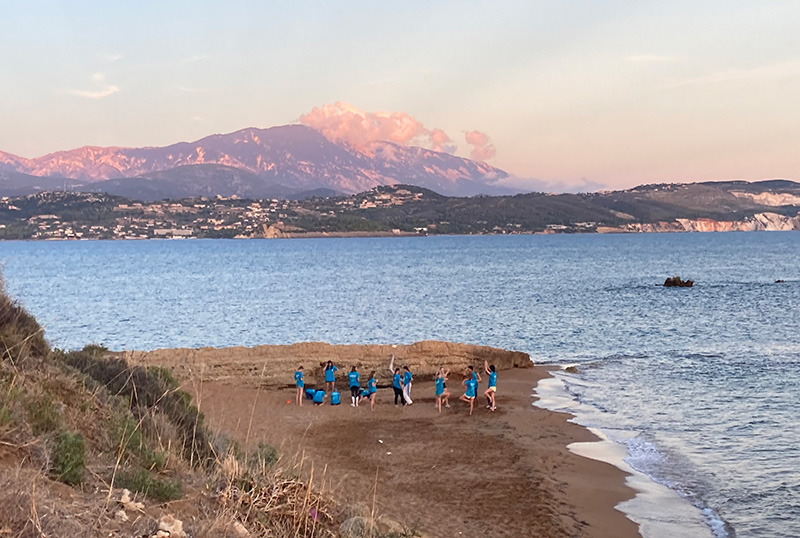
As if inventorying these two nests was not enough excitement for one evening, VR6R began hatching! As it was still light our volunteers watched over the six hatchlings to ensure that they got to the sea safely. Our volunteers on morning survey counted more tracks from hatchlings that had come from Vrahanari during the night, as well as a couple of them being found which came out just before they arrived. Before leaving the beach, the team was stopped by a tourist who showed them a video of hatchlings coming out from another nest on Vrahanari. Despite not speaking any English a conversation over Google Translate revealed that she had seen around 16 hatchlings at 1 pm the day before. Luckily it was a fairly cool day, and the hatchlings were watched over by tourists- all making it to sea. By the time we arrived for inventory the tracks had already been scrubbed due to the wind, so we are very grateful to have received the information about this hatching- especially as it was the first hatching for this nest! Over the following days, the nest on Vrahanari continued to hatch well, with 8 tracks on Tuesday, Wednesday, and Thursday morning. On Friday we inventoried the nest to find 99 hatched eggs out of 109! This is a great success so far, and 5 eggs were reburied, which may hatch in the coming days.
The last remaining nest on the Cape was inventoried on Tuesday. Being on one of our closer beaches lots of volunteers chose to cycle down to help. There were 46 hatched eggs out of 72, and one hatchling in the egg chamber. This was very exciting for some of our volunteers for whom it was their first time seeing a hatchling!
Whilst the evenings are cooling down, our activity nights are continuing to relight the fire in our volunteers! We are staying cosy outdoors with group movie nights, a favourite amongst our volunteers. This week’s big watch was Finding Nemo, inspired by our many trips to our favourite aquarium, our volunteers all snuggled down with snacks and it made it to be a very memorable evening! Aside from movie night, we have had lots of other fun activities going on, all accompanied by ice cream and souvlaki. Our most popular activity, henna night, went down a treat once again with all of our volunteers doodling some interesting-looking turtles onto their new friends- what a way to bond! They have thoroughly enjoyed group cooking this week, taking it upon themselves to organise and cook for each other, having wonderful dishes like fajitas and curry, it’s been especially well received by those coming home from shift to a hot meal made by their friends. This week our volunteers have been very eager to explore other places on the island, getting busses and hiring cars to visit the beautiful spots such as Fiskardo, Poros and Melissani caves, whilst others have spent their free time relaxing at our beautiful nesting beaches, playing volleyball and lounging in the sun.
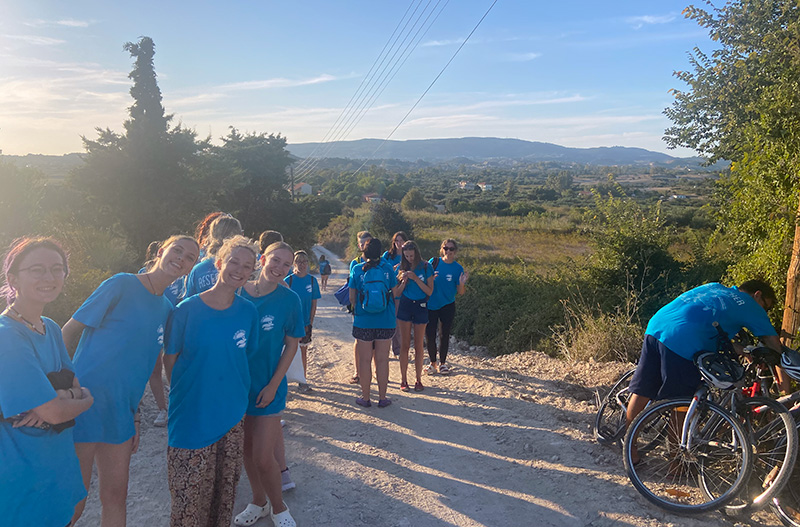
All their downtime and relaxation are well deserved, our volunteers have been amazing in this past week, going above and beyond in all aspects of their shifts, even opting to do shifts on their days off because they enjoy them so much! Memories have truly been made this week, with the most beautiful sunrises and sunsets over our sandy shores, seeing hatchlings start their journey and eating souvlaki by the sea, we have created friends for life. All good friendships start with a sunrise morning survey! As we say another teary-eyed goodbye to our new lifelong friends, we are excited to welcome our last group of the season here in Lixouri.
Skala Field Station
This week brings the closing week to our project in Skala and it’s been a fun and amazing first year for Wildlife Sense. Even though this is our last week, the team continues to work very hard despite the weather getting colder. Every one of our volunteers is as dedicated as ever to collect as much data as possible on Posidonia, Drone and Sand Dune Surveys.
We had a new volunteer join us this week who has volunteered for a lot of great causes worldwide and she is ready to get stuck in. On one of our Posidonia surveys later on in the week, our team counted four starfish in the sea which was very exciting to come across.
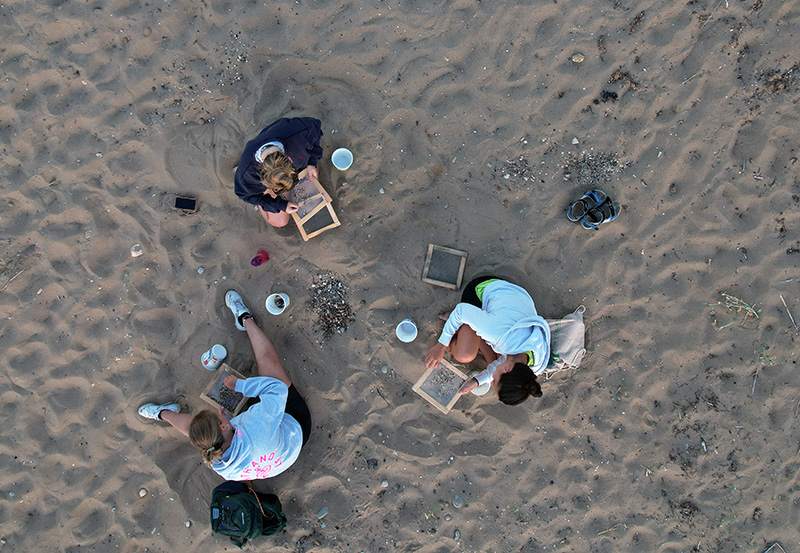
We have managed to collect lots of important data this season. For instance, throughout the season we have covered over 1,925 quadrants which means we have studied a huge surface area of the sand dunes. All of this data will be vital in helping us understand the state and health of the sand dunes. The more vegetation there is, the more stable the sand dunes are and this helps the overall functioning of this important ecosystem. Our volunteers have recorded Sand Couch Grass (Elymus Farctus) to be the most common plant on the sand dunes at Mounda beach and Skala beach, having been recorded 568 times over the season. Sea Daffodils (Pancratium Maritima) are the second most popular plant seen on our beaches here in Skala and were recorded 471 times.
In terms of Posidonia surveys, we have carried out 53 surveys overall. From this, we have found that there are fully grown meadows on rocks and not so many on the sand. However, we have seen a lot of young Posidonia growing on the sand. Unfortunately, we see that in areas where boats choose to moor, anchors and chains cause a lot of damage to places where Posidonia grows. This highlights how important it is to collect this data so we know more about where Posidonia grows and where more of it needs to be to protect the health of the ocean and the wildlife that inhabit it.
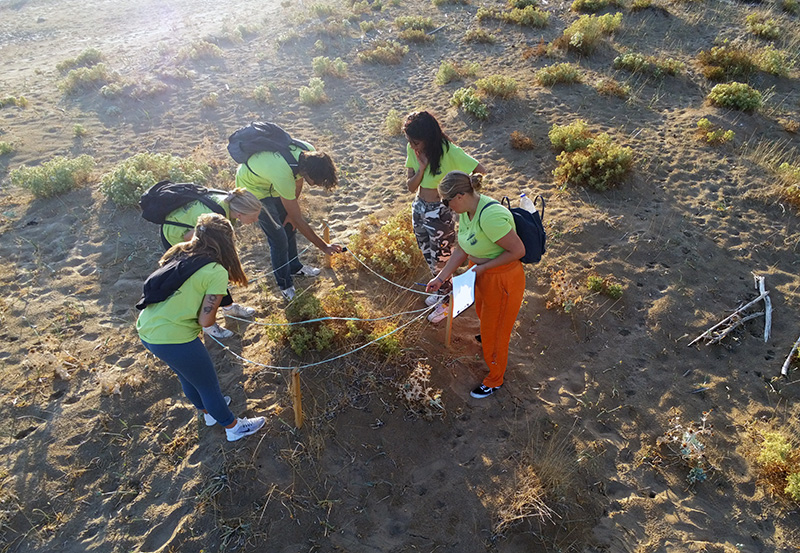
Litter surveys have also been a huge part of our season, having collected around 70 bags of litter, ensuring that we are keeping our beaches clean. Finally, in the last two months, our volunteers have collected over a litre and a half of microplastics which have been buried in the sand on Mounda. Microplastics can be very harmful to wildlife so it is really important to get as much of this off the beach as possible.
As a team, we enjoyed activity evenings together for our final weeks such as games night and souvlaki night. Later on this week, we will have one final meal together as a roundup of an amazing two weeks and overall season. We thank all of our current and past volunteers for all of their hard work in helping us collect vital data to protect the wonderful ecosystems that we have here in Kefalonia, Greece.
Written by Emma Hawkes

